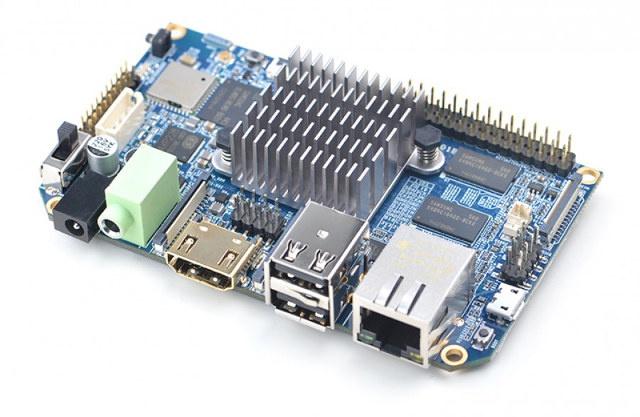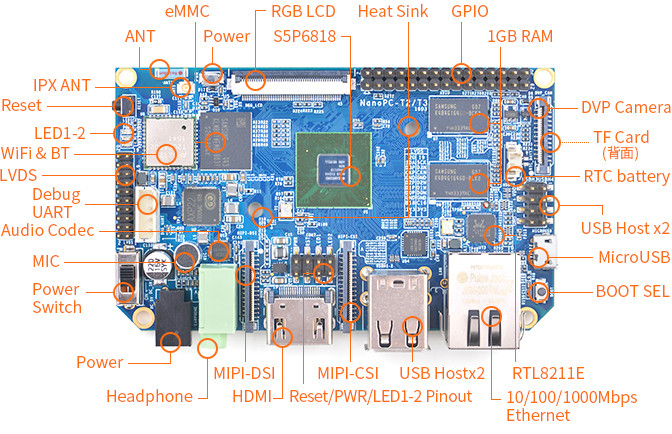FriendlyARM launched NanoPC-T2 single board computer based on Samsung 5P4418 quad core Cortex A9 processor about 3 months ago, and the company has now an update based on Samsung S5P6818 Octa-Core A53 processor with the exact same interfaces and features including Gigabit Ethernet, WiFI, and Bluetooth, HDMI 1.4a, 30-pin expansion headers, etc…

NanoPC-T3 specifications:
- SoC – Samsung S5P6818 octa core Cortex A53 processor @ up to 1.4GHz with Mali-400MP GPU
- System Memory – 1 or 2GB 32bit DDR3 RAM
- Storage – 8GB eMMC flash, and 1x SD card slot
- Connectivity – Gigabit Ethernet (RTL8211E), 802.11 b/g/n WiFi and Bluetooth LE 4.0 (Ampak AP6212) with on-board chip antenna and IPX antenna connector
- Video Output / Display I/F- 1x HDMI 1.4a, LVDS, MIPI DSI, parallel RGB LCD
- Audio I/O – HDMI, 3.5mm audio jack, on-board microphone
- Camera – 1x DVP interface, 1x MIPI CSI interface
- USB – 2x USB 2.0 type A host ports; 1x micro USB 2.0 OTG port; 2x USB 2.0 host ports via 8-pin header
- Expansions Headers – 30-pin header for GPIO, 8-pin header for power signals, reset and LED 1-2
- Debugging – 4-pin header for serial console
- Misc – Power switch, reset button, 1x power & 2x user LEDs, RTC battery header, boot selection button (SD card / eMMC)
- Power Supply – 5V/2A via power barrel; AXP228 PMIC
- Dimension – 100 x 60 mm (6-layer PCB)
 The board can run Android and Debian from eMMC flash or SD card like its predecessor, as well as Ubuntu Core with Qt, and software and hardware documentation can be found on the Wiki. The board ships with the heatsink shown in the top picture.
The board can run Android and Debian from eMMC flash or SD card like its predecessor, as well as Ubuntu Core with Qt, and software and hardware documentation can be found on the Wiki. The board ships with the heatsink shown in the top picture.
The board can be bought on FriendlyARM website for $60 + shipping via China Post ($10), Fedex ($14) or DHL ($34). Shipping fees in brackets are for my location, so you may get other quotes.

Jean-Luc started CNX Software in 2010 as a part-time endeavor, before quitting his job as a software engineering manager, and starting to write daily news, and reviews full time later in 2011.
Support CNX Software! Donate via cryptocurrencies, become a Patron on Patreon, or purchase goods on Amazon or Aliexpress




2GB RAM option is good (really helps with self-hosted development), but eMMC is 8GB only?
How can we use the 8pins USB headers to get 2 x USB 2.0 ports? So there are a possiblilty of using a total of 5 USB 2.0 disks if micro USB 2.0 OTG port is also used as host?
@Fossxplorer
I think it’s useful if you have your own modules that use USB signals without actually using a USB port, so you can just wire your module directly to the board.
Not sure about supporting 5 USB drives.
@Fossxplorer
The SoC has only 1 host, 1 OTG and 1 HSIC USB2.0 port and it seems a Genesys Logic USB hub is on the board next to the 2 USB receptacles. So you’ll end up with all 4 USB host ports connected to the one single HSIC port sharing bandwidth. I’ve not seen any octa-core board so far that doesn’t suck regarding I/O bandwidth 🙂
Kernel version 3.4 🙂
Pretty sure there’s no arm64 support there, those a53 will run on 32bit only
@memeka
i don’t trust their wiki for now, it seems to be a copy-paste from other older devices
the hardware looks really nice, the price is okay-ish (2GB ram would have been nice), but i fear the software support/community might be lacking
No usb3, no buy.
When will these SBC designers learn Any thing less than four USB ports is unrealistic for practical use among the broad majority of consumers.
What is the obesssion with usb ports here?, who needs them on an embedded controller.
@tkaiser, i see. And thanks for answering a question i was about to ask, but already informed by you. This is very important details most ppl don’t know prior to buying such.
I’ve read many other comments and forum threads by you which enlighten us about the shortcoming of these devices. Really appreciate your effort and time figuring out of such crucial details!
@Jeroen
Yeah, especially since the ‘need’ to provide as much USB receptacles as possible leads often to strange design desicions further limiting available bandwidth. Best/worst example is Banana Pi M3: The SoC features 2 real USB host ports and the board has 2 USB type A receptacles. But since the vendor promotes also a SATA port (behind an ultra slow USB-to-SATA bridge limiting disk write performance to 15MB/s!) you end up with only one USB host port used and both disk port and the 2 external USB receptacles connected to this so everything has to share the bandwidth of only one port.
I would prefer if board vendors make all real USB ports directly available but stop to use slow/crappy internal USB hubs while not exposing real USB ports at the same time. But maybe shared bandwidth doesn’t matter for the aforementioned ‘broad majority of consumers’?
mali 400mp
no usb
no sata
no go for me
Hello, can I buy with board NanoPC-T3 board with DDR3 2GB RAM? I know default it’s 1Gb DDR
@HuyLe
I can’t see it on their website, so you may have to talk to FriendlyARM directly to find out how to buy it.
NanoPC-T3 Plus with 2GB RAM is now up for sale for $75 @ http://www.friendlyarm.com/index.php?route=product/product&path=69&product_id=210
Friendlyelec have launched a sheet metal case for the NanoPC-T3 Plus $9.99 + p&p
Does anyone know if HDMI CEC is supported?
New Nano Pi 7″ display
https://www.friendlyarm.com/index.php?route=product/product&product_id=250